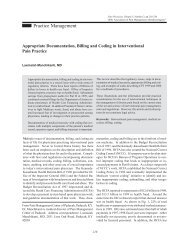ASIPP Practice Guidelines - Pain Physician
ASIPP Practice Guidelines - Pain Physician
ASIPP Practice Guidelines - Pain Physician
Create successful ePaper yourself
Turn your PDF publications into a flip-book with our unique Google optimized e-Paper software.
Manchikanti et al • <strong>ASIPP</strong> <strong>Practice</strong> <strong>Guidelines</strong><br />
25<br />
Agency for Health Care Policy and Research (AHCPR),<br />
which replaced the National Center for Health Services<br />
Research and Health Care Technology Assessment<br />
(NCHSR) in 1989 (28). The Agency for Health Care Policy<br />
and Research developed approximately 15 guidelines, with<br />
a budget of $750 million. The guidelines developed by<br />
AHCPR for managing acute low back pain are of significant<br />
importance for practice of interventional pain medicine<br />
(28). Other guidelines of significance for pain specialists<br />
include those developed by the Quebec Task Force<br />
in the management of spinal disorders and whiplash associated<br />
disorders (29, 30), chronic pain management guidelines<br />
by the American Society of Anesthesiologists (31),<br />
guidelines for performance of facet joint blocks by the International<br />
Spinal Injection Society (32), and interventional<br />
techniques in the management of chronic pain by the Association<br />
of <strong>Pain</strong> Management Anesthesiologists (33).<br />
Additionally, there are guidelines for migraine headaches<br />
(34), guidelines for managing pain in sickle cell disease<br />
(35), chronic pain management guidelines in the elderly<br />
(36), and guidelines the for management of chronic pain<br />
syndrome (37, 38). Other guidelines include the ones developed<br />
by local Medicare carriers in the form of local<br />
Medicare Review Policies in various states; third-party<br />
payors including Blue Cross and Blue Shield, Aetna and<br />
others; entrepreneurial technological companies such as<br />
Hayes Technologies; and position statements by a multitude<br />
of individuals and organizations. Cochrane collaboration<br />
back review group for spinal disorders was also<br />
started in 1995 (39, 40). McQuay and Moore published a<br />
book of evidence based resource for pain relief (3). Many<br />
of these guidelines were developed at a cost of tremendous<br />
effort and resources to review the assessment and treatment<br />
literature and to develop evidence-based guidelines<br />
to treat various conditions. However, the cost of the guidelines<br />
by various organizations is much less than the ones<br />
developed by the federal government by the AHCPR. A<br />
serious examination of the guidelines shows that about 85%<br />
of the recommendations are not based on any significant<br />
evidence (27). Interventional pain management is no exception<br />
to the general rule.<br />
Purpose<br />
CLINICAL PRACTICE GUIDELINES<br />
Clinical practice guidelines for interventional techniques<br />
in the management of chronic pain are professionally developed<br />
utilizing a combination of evidence, expert opinion<br />
and consensus. The purpose of these clinical guidelines<br />
is to:<br />
1. Improve quality of care,<br />
2. Improve patient access,<br />
3. Improve patient outcomes,<br />
4. Improve appropriateness of care,<br />
5. Improve efficiency and effectiveness, and<br />
6. Achieve cost containment by improving cost-benefit<br />
ratio.<br />
Rationale<br />
The most compelling single reason for the development of<br />
these clinical practice guidelines is to improve the quality<br />
of care and life for patients suffering from painful disorders.<br />
Available evidence documents a wide degree of variance<br />
in the practice of interventional pain management and<br />
pain medicine for even the most commonly performed procedures<br />
and treated condition(s) (6, 23-38, 41-63). These<br />
guidelines also address the issue of systematic evaluation<br />
and ongoing care of chronic or persistent pain, and provide<br />
information about the scientific basis of recommended<br />
procedures, thus potentially increasing compliance, dispelling<br />
misconceptions among providers and patients,<br />
managing patient expectations reasonably, and forming the<br />
basis of a therapeutic partnership among the patient, the<br />
provider, and the payer.<br />
Importance<br />
Interventional techniques are crucial both in the diagnostic,<br />
as well as the therapeutic, arena of managing pain and<br />
providing improvement in the quality of life of the pain<br />
sufferers. Some insurance carriers and other medical specialties<br />
have criticized the practice of interventional pain<br />
medicine and pain management using the wide variations<br />
in treatment protocols and the relative scarcity of conclusive<br />
evidence or consensus for their justification.<br />
Methodology<br />
The two most common methods for the development of<br />
guidelines, often combined, are based on evidence and<br />
consensus. However, reviews, clinical decision analyses,<br />
and economic analyses are also very commonly utilized in<br />
the medical literature. Thus, clinicians are increasingly<br />
being asked to remain current in the aspects of clinical<br />
care and decision making by systematically gathering, analyzing,<br />
and combining evidence that links to outcome (6).<br />
However, many of these publications unfortunately do not<br />
always link information in a direct way to clinical recommendations<br />
(3-5, 24, 25, 64). Implicit in the definition of<br />
<strong>Pain</strong> <strong>Physician</strong> Vol. 4, No. 1, 2001
















